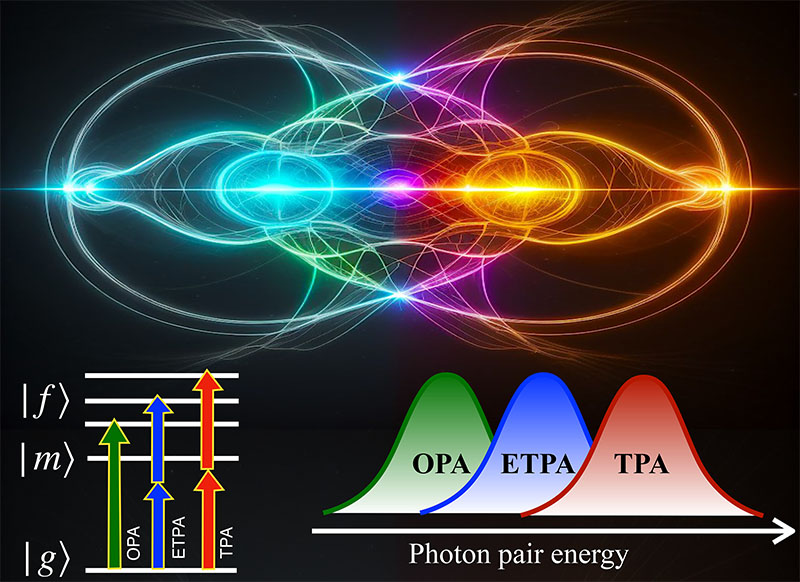| Jul 17, 2024 |
Quantum light unlocks nature's tiny secrets
(Nanowerk News) Researchers at the University of Michigan have found a way to examine tiny structures, such as bacteria and genes, with reduced damage compared to traditional light sources.
|
|
The new technique involves spectroscopy, which is the study of how matter absorbs and emits light and other forms of radiation, and it takes advantage of quantum mechanics to study the structure and dynamics of molecules in ways that are not possible using conventional light sources.
|
|
“This research examined a quantum light spectroscopy technique called entangled two-photon absorption (ETPA) that takes advantage of entanglement to reveal the structures of molecules and how ETPA acts at ultrafast speeds to determine properties that cannot be seen with classical spectroscopy,” said study senior author Theodore Goodson, U-M professor of chemistry and of macromolecular science and engineering.
|
|
Entangled two-photon absorption allows researchers to study molecules by using two photons that are interconnected through a quantum phenomenon known as entanglement.
|
 |
| Schematic representation of the ETPA peak with respect to the absorption peak position for classical TPA and for one-photon resonant absorption (OPA). (© PNAS)
|
|
Photons are the smallest possible particles of electromagnetic energy and, therefore, also the smallest particles of light, allowing details about the molecule’s structure to be visible—which cannot be shown with regular light. Quantum light spectroscopy is very fast and can reveal properties that are usually hidden.
|
|
The discovery opens opportunities for non-invasive, low-intensity imaging and sensing applications with minimal photodamage to delicate biological samples like proteins, DNA, and living cells.
|
|
“Measurements with entangled photons may enable sensing biological signatures with high selectivity and at very low light levels to protect against photodamage,” said lead author Oleg Varnavski, a research lab specialist in the U-M Department of Chemistry.
|
|
The research, published in the Proceedings of the National Academy of Sciences ("Colors of entangled two-photon absorption"), used an organic molecule called zinc tetraphenyl porphyrin to study the phenomenon of two-photon absorption – where a molecule simultaneously absorbs two particles of light instead of one.
|
|
Researchers found that using pairs of photons that were quantumly entangled, the ZnTPP molecule exhibited absorption in the red spectrum. With two untangled photons, the ZnTPP molecules showed absorption in a blue spectrum.
|
|
A laser produced pairs of entangled photons through a process called spontaneous parametric down-conversion. These photons were then focused onto a cuvette containing the ZnTPP solution. The transmission was measured using a highly sensitive single-photon detector.
|
|
This work paves the way for the advancement of quantum light-based spectroscopy and microscopy, potentially leading to much higher efficiency of ETPA sensors and low-intensity detection schemes. The ability to access unique molecular states with entangled photons could improve the sensing of biological signatures with significant selectivity and sensitivity even at minimum light levels to prevent photodamage.
|
|
“This provides the opportunity to study states of molecules with nonclassical light that have fundamentally different properties than are accessible with classical light,” Varnavski said.
|

